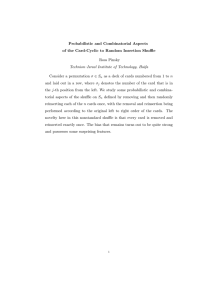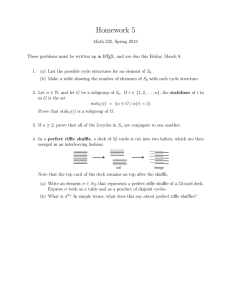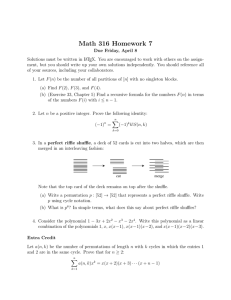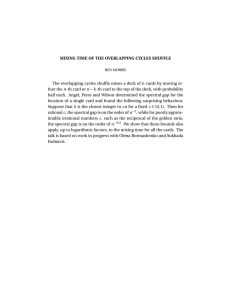The overhand shuffle mixes in Θ(n logn) steps
advertisement
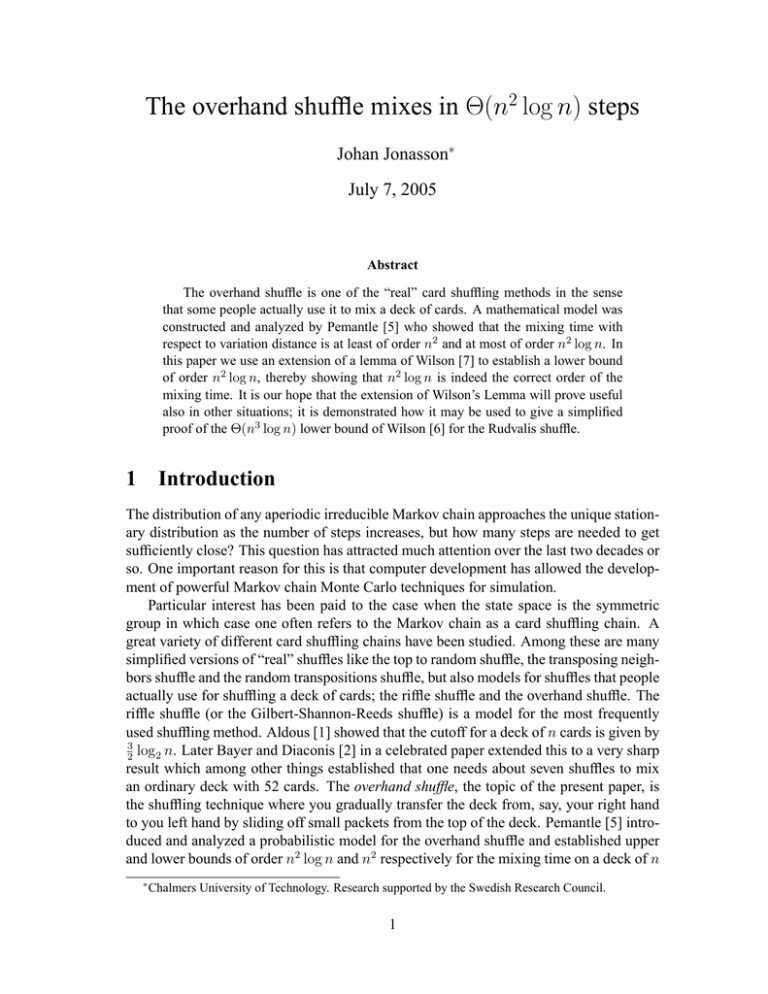
The overhand shuffle mixes in Θ(n2 log n) steps
Johan Jonasson∗
July 7, 2005
Abstract
The overhand shuffle is one of the “real” card shuffling methods in the sense
that some people actually use it to mix a deck of cards. A mathematical model was
constructed and analyzed by Pemantle [5] who showed that the mixing time with
respect to variation distance is at least of order n2 and at most of order n2 log n. In
this paper we use an extension of a lemma of Wilson [7] to establish a lower bound
of order n2 log n, thereby showing that n2 log n is indeed the correct order of the
mixing time. It is our hope that the extension of Wilson’s Lemma will prove useful
also in other situations; it is demonstrated how it may be used to give a simplified
proof of the Θ(n3 log n) lower bound of Wilson [6] for the Rudvalis shuffle.
1 Introduction
The distribution of any aperiodic irreducible Markov chain approaches the unique stationary distribution as the number of steps increases, but how many steps are needed to get
sufficiently close? This question has attracted much attention over the last two decades or
so. One important reason for this is that computer development has allowed the development of powerful Markov chain Monte Carlo techniques for simulation.
Particular interest has been paid to the case when the state space is the symmetric
group in which case one often refers to the Markov chain as a card shuffling chain. A
great variety of different card shuffling chains have been studied. Among these are many
simplified versions of “real” shuffles like the top to random shuffle, the transposing neighbors shuffle and the random transpositions shuffle, but also models for shuffles that people
actually use for shuffling a deck of cards; the riffle shuffle and the overhand shuffle. The
riffle shuffle (or the Gilbert-Shannon-Reeds shuffle) is a model for the most frequently
used shuffling method. Aldous [1] showed that the cutoff for a deck of n cards is given by
3
log2 n. Later Bayer and Diaconis [2] in a celebrated paper extended this to a very sharp
2
result which among other things established that one needs about seven shuffles to mix
an ordinary deck with 52 cards. The overhand shuffle, the topic of the present paper, is
the shuffling technique where you gradually transfer the deck from, say, your right hand
to you left hand by sliding off small packets from the top of the deck. Pemantle [5] introduced and analyzed a probabilistic model for the overhand shuffle and established upper
and lower bounds of order n2 log n and n2 respectively for the mixing time on a deck of n
∗
Chalmers University of Technology. Research supported by the Swedish Research Council.
1
cards. Here we will establish a lower bound of order n2 log n, thereby proving Pemantle’s
upper bound to be essentially tight. The main tool of our analysis is a technique introduced by Wilson [7] where one cleverly uses an eigenvalue close to 1 and a corresponding
eigenvector of the transition matrix of the motion of a single card in order to find a useful
eigenvector of the whole chain. This eigenvector exhibits a certain contraction property
and the random variable obtained by evaluating it at the state at time t can often be proved
to be close to its expectation with high probability. In [7] this technique is used to prove
an order n3 log n lower bound for the transposing neighbors shuffle and in [6] a version
for a lifted Markov chain is used to establish a lower bound of the same order for the Rudvalis shuffle. Mossel, Peres and Sinclair [4] use the technique to prove an n log n lower
bound for the so called cyclic to random shuffle.
In Section 2 we review some basic definitions and describe Pemantle’s model for the
overhand shuffle and Wilson’s technique. In Section 3 we state and prove the promised
lower bound for the overhand shuffle. In order to do this we will have to extend Wilson’s
technique slightly and use a vector that is not really but only very close to an eigenvector of
the transition matrix. We hope that this extension turns out to be useful in other situations
as well. In Section 4 we demonstrate how it can be used to give a simplified proof of
Wilson’s [6] Ω(n3 log n) lower bound for the Rudvalis shuffle.
2 Preliminaries
2.1 Basic definitions
The standard way of measuring the distance between two probability measures µ and ν
on a finite set S is by the total variation norm defined by
1X
kµ − νk =
|µ(S) − ν(S)| = max(µ(A) − ν(A)).
A⊆S
2 s∈S
Let {Xtn }∞
t=0 , n = 1, 2, 3, . . ., be a sequence of aperiodic irreducible Markov chains on
state spaces S n and with stationary distributions π n . Assume that |S n | ↑ ∞ in a natural
way. A sequence {f (n)}∞
n=1 is said to be an upper bound for the mixing time of the
sequence of Markov chains if
lim kP (Xfn(n) ∈ ·) − π n k = 0
n→∞
and a lower bound if
lim kP (Xfn(n) ∈ ·) − π m k = 1.
n→∞
When, for any a > 0, (1−a)f (n) is a lower bound and (1+a)f (n) is an upper bound, one
says that f (n) is a cutoff or a threshold for the mixing time. In card shuffling situations,
as in the present paper, S n = Sn , the set of permutations of n cards, and usually π n is
U = U n , the uniform distribution on Sn .
2.2 The overhand shuffle
Pemantle’s model for the overhand shuffle is parameterized by a probability p ∈ (0, 1).
The transition rule is the following: Each of the n − 1 slots between adjacent cards is,
2
independently of the other slots, declared a cutpoint with probability p. This divides in
a natural way the deck into subsequences, or packets, of cards. Reverse each of these
packets without changing its position relative to the other packets. (This is not what
really happens when doing an overhand shuffle; what we get is rather the reversed deck
compared to what one would have got from the overhand shuffle. This of course does not
matter for the mixing time.)
For this Markov chain Pemantle obtained an O(n2 log n) upper bound by constructing
a coupling for which he was able to demonstrate that one can find a constant C < ∞
such that each card is with high probability matched within Cn2 log n steps. Intuitively
one can understand this by observing that a particular card makes a random walk which
is essentially symmetric (at least when the card is not at O(1) distance from the ends of
the deck) with step size variance of constant order. Therefore one should be able to match
the typical card within O(n2 ) steps and all cards within O(n2 log n) steps. Studying the
random walks of single cards also quickly yields an Ω(n2 ) lower bound since before this
time too many of the cards are too close to their starting positions.
2.3 Wilson’s technique
The key to the technique is the following lemma from [7]. Later on, an extension of the
lemma will be needed together with corresponding adjustments of its proof. We prove
the original lemma here in order to make the later proof of the extension easier to digest;
doing both at once may hide the essential ideas behind technical details.
L EMMA 2.1 (The lower bound lemma) Let {Xt }∞
t=0 be an aperiodic irreducible Markov
chain with state space S and stationary distribution π. Assume that Φ : S → R and
γ ∈ (0, 21 ) are such that
E[Φ(Xt+1 )|Xt ] = (1 − γ)Φ(Xt ).
(I.e. 1−γ is an eigenvalue for the transition matrix and Φ is a corresponding eigenvector.)
Suppose that R ≥ maxs∈S E[(Φ(Xt+1 ) − Φ(Xt ))2 |Xt = s], put Φ̂ = maxs∈S Φ(s) and
let the chain start from a state s0 such that Φ(s0 ) = Φ̂.
Fix ǫ > 0 and put
T =
log Φ̂ − 21 log 4R
γǫ
− log(1 − γ)
.
Then for t ≤ T
kP (Xt ∈ ·) − πk ≥ 1 − ǫ.
The lemma may be adopted to situations with complex-valued eigenvalues and eigenvectors as well, but we will not need that here; the overhand shuffle clearly defines a
reversible Markov chain.
Proof. By induction EΦ(Xt ) = (1 − γ)t Φ(s0 ) and consequently EΦ(X∞ ) = 0. Put
∆Φ = Φ(Xt+1 ) − Φ(Xt ). Then
E[Φ(Xt+1 )2 |Xt ] = (1 − 2γ)Φ(Xt )2 + E[(∆Φ)2 |Xt ] ≤ (1 − 2γ)Φ(Xt )2 + R.
3
Using induction and that γ ≤ 1/2 we get
E[Φ(Xt )2 ] ≤ (1 − 2γ)t Φ(s0 )2 +
R
.
2γ
Thus, since γ ≤ 1/2,
VarΦ(Xt ) ≤ Φ(s0 )2 ((1 − 2γ)t − (1 − γ)2t ) +
R
R
≤
.
2γ
2γ
By Chebyshev’s inequality
³
P |Φ(Xt ) − EΦ(Xt )| ≥
s
R´ ǫ
≤
γǫ
2
and by letting t → ∞ it also follows that
s
³
R´ ǫ
≤ .
P |Φ(X∞ )| ≥
γǫ
2
p
p
Now if t is such that EΦ(Xt ) ≥ 2 R/(γǫ) then we get that P (Φ(Xt ) ≤ R/(γǫ)) ≤
ǫ/2 and so
kP (Xt ∈ ·) − P (X∞ ∈ ·)k ≥ 1 − ǫ
aspdesired. It remains to determine for which t we have EΦ(Xt ) = (1 − γ)t Φ̂ ≥
2 R/(γǫ). Some simple algebraic manipulations show that this is the case when t ≤ T .
2
There is more to using the lower bound lemma than just the lemma itself: In order
to derive good lower bounds one needs to find an eigenvalue sufficiently close to 1 and a
useful corresponding eigenvector. It is not at all obvious how to do that. In [7], and also
in [6] and [4], one may find some useful hints on how this may be done.
3 Lower bound for the overhand shuffle
Let Xt denote the state of the deck at time t and let Zt = Zti denote the position of card
i at time t. For simplicity we shall do the the case p = 1/2 and leave the straightforward
generalization to the reader. To further simplify our calculations we will to begin with
assuming a circular deck convention, i.e. regarding the top card and the bottom card as
being next to each other. This means that the top packet and the bottom packet may be
treated as a single packet (if the slot between that top and the bottom card happens to be a
cutpoint). Then any single card performs a symmetric random walk where the probability
that the card moves k steps to the right (modulo n) at a single shuffle is 31 ( 21 )|k| , k ∈ Z. 1
1
A negative k of course means that the card moves to the left. The given step size distributions is not
entirely correct because of the remote possibility that at a given shuffle there are no cutpoints at all or only
one cutpoint. However the probability that this ever happens in the time scale we are interested in is so
small that we do not need to care about this. If we want to make the formula completely correct we may
just redefine the shuffle on this event in a suitable way.
4
We start with the circular deck convention since it produces a much cleaner proof than the
“real” overhand shuffle. At the end of this section the circular convention will be removed
via a slight extension of the lower bound lemma.
To find an eigenvector for the {Zt }-chain we use the cosine function: (Note that
cos(2πk/n) is well defined on Zn .)
∞
1
2πZt 1 X 1
2π(Zt − k)
2π(Zt + k)
2πZt+1
|Xt ] = cos
+
(cos
+ cos
)
E[cos
k
n
3
n
3 k=1 2
n
n
∞
X
cos 2πk
2πZt
2πZt
1
n
)(1 + 2
) = (1 − γ) cos
= (cos
k
3
n
2
n
k=1
where γ = (1 + o(1))8π 2 n−2 , which follows from
that for k = o(n) one has
Pthe fact
2 −k
cos(2πk/n) = 1−2π 2 k 2 n−2 +O(k 4 n−4 ), and that ∞
k
2
= 6. The second equality
k=1
follows from the standard trigonometric formula for the cosine of a sum.
Now put m = ⌊n/2⌋ and
Φ(Xt ) =
m
X
i=1
2πZti
.
cos
n
Then Φ is an eigenvector corresponding to the eigenvalue 1 − γ for the transition matrix
of the whole deck, and Φ̂ = Cn for C = Θ(1). In order to use the lower bound lemma
we need to bound E[(Φ(Xt+1 ) − Φ(Xt ))2 |Xt ]. Write
Yi = cos
i
2πZt+1
2πZti
− cos
.
n
n
Then
m
m X
m
X
X
2
E[(Φ(Xt+1 ) − Φ(Xt )) |Xt ] = E[(
Yi ) |Xt ] =
E[Yi Yj |Xt ].
2
i=1
i=1 j=1
Let A denote the event that no two cutpoints of the t + 1’th shuffle are more than 10 log n
steps apart. It is easily verified that P (A) = 1 − o(n−5 ).
Consider a given pair (i, j) of cards that at time t are more than 20 log n apart. Ideally,
if card i and card j were infinitely far apart at time t, then Yi and Yj would have been
independent. Put Yi′ and Yj′ for such idealized independent random variables. By the
definition of A we can couple Yi and Yj with Yi′ and Yj′ in such a way that Yi = Yi′ and
Yj = Yj′ on A. (Such a coupling can be made by coupling the cutpoints for the two cases
in a natural way.) Thus
E[Yi Yj |Xt ] = E[Yi′ Yj′ IA |Xt ] + o(n−5 ) = E[Yi′ |Xt ]E[Yj′ |Xt ] + o(n−5 )
= E[Yi |Xt ]E[Yj |Xt ] + o(n−5 ).
By mimicking the above calculations it follows that E[Yi |Xt ] = O(n−2 ) and so
E[Yi Yj |Xt ] = O(n−4 ).
5
Using this it follows that
E[(Φ(Xt+1 ) − Φ(Xt ))2 |Xt ] =
m
X
X
E[Yi Yj |Xt ] + O(n−2 )
i=1 j:|Z i −Z j |≤20 log n
t
t
=
m
X
X
Cov(Yi , Yj |Xt ) + O(n−2 ) ≤ 20V n log n
i=1 j:|Z i −Z j |≤20 log n
t
t
where
V = max Var(Yi |Xt = s) ≤ max E[Yi2 |Xt = s]
s∈Sn
s∈Sn
∞
8 X sin2 2πk
n
≤ 100n−2
=
3 k=1 2k
for large enough n. Hence
E[(Φ(Xt+1 ) − Φ(Xt ))2 |Xt ] ≤ 2000n−1 log n
and we may apply the lower bound lemma with R = 2000n−1 log n. In order to have
ǫ → 0, let ǫ = (log n)−1 . The lower bound lemma now yields the lower bound
n2 ³
1
1 2
8000n(log n)2 ´
T = (1 + o(1)) 2 log(Cn) − log
= (1 + o(1))
n log n.
2
8π
2
8π
16π 2
P
2
j
Finally for general p, the analogous calculations using that ∞
k=1 j (1−p) = (2−p)(1−
3
p)/p give:
T HEOREM 3.1 A lower bound for the overhand shuffle with circular deck convention and
with parameter p ∈ (0, 1) is given by
p2 (2 − p) 2
n log n.
8π 2 (1 − p2 )
Next we remove the circular deck convention. We will again concentrate on the case
p = 1/2. The vector Φ above is now no longer really an eigenvector for {Xt } but only
very close to one; in particular the cards near the ends of the deck do not behave well.
However the feeling is that the small error we make if we still assume that Φ is an eigenvector should not be large enough to upset things too much. This is made precise by the
following extension of the lower bound lemma:
L EMMA 3.2 (The extended lower bound lemma) Let the setting be as in the lower
bound lemma with the exception that Φ is not an eigenvector for the transition matrix, but
there is a positive number ρ such that
(1 − γ)Φ(Xt ) − ρ ≤ E[Φ(Xt+1 )|Xt ] ≤ (1 − γ)Φ(Xt ) + ρ
a.s. Then, for t ≤ T , kP (XT ∈ ·) − πk ≥ 1 − ǫ where
q
³
´
4(R+6ρΦ̂)
log Φ̂ − log 2ρ
+
γ
γǫ
T =
.
− log(1 − γ)
6
Proof. The proof is basically a repetition of the proof of the lower bound lemma,
with the proper adjustments: By induction we get
(1 − γ)t Φ(s0 ) −
ρ
ρ
≤ EΦ(Xt ) ≤ (1 − γ)t Φ(s0 ) +
γ
γ
i.e. for some α ∈ [−1, 1],
EΦ(Xt ) = (1 − γ)t Φ(s0 ) −
αρ
γ
and by letting t → ∞ we also get
−
ρ
ρ
≤ EΦ(X∞ ) ≤ .
γ
γ
We have
E[Φ(Xt )2 |Xt ] ≤ Φ(Xt )2 + 2Φ(Xt )E[∆Φ|Xt ] + R
≤ (1 − 2γ)Φ(Xt )2 + 2ρ|Φ(Xt )| + R ≤ (1 − 2γ)Φ(Xt )2 + 2ρΦ̂ + R.
By induction
E[Φ(Xt )2 ] ≤ (1 − 2γ)t Φ(s0 )2 +
R + 2ρΦ̂
.
2γ
VarΦ(Xt ) ≤ (1 − 2γ)t Φ(s0 )2 +
αρ 2
R + 2ρΦ̂
− ((1 − γ)t Φ(s0 ) −
)
2γ
γ
Thus
R + 2ρΦ̂ 2|α|ρΦ̂(1 − γ)t
R + 6ρΦ̂
+
≤
.
2γ
γ
2γ
By Chebyshev’s inequality
s
³
R + 6ρΦ̂ ´ ǫ
≤
P |Φ(Xt ) − EΦ(Xt )| ≥
γǫ
2
≤
and by letting t → ∞, using that EΦ(X∞ ) ≤ ρ/γ,
s
³
R + 6ρΦ̂ ´ ǫ
ρ
≤ .
P |Φ(X∞ )| ≥ +
γ
γǫ
2
q
Thus kP (Xt ∈ ·) − πk ≥ 1 − ǫ when t is such that EΦ(Xt ) ≥ ρ/γ + 2 (R + 6ρΦ̂)/(γǫ).
Since EΦ(Xt ) ≥ (1 − γ)t Φ̂ − ρ/γ this holds when t ≤ T . 2
In our case γ = Θ(n−2 ), R = O(n−1 log n) (the above arguments apply equally
well to the present setting without the circular deck convention) and Φ̂ = O(n). Hence,
once it has been shown that ρ = O(n−2+δ ) for any δ > 0, then we get the same lower
bound that we got with the circular deck convention. In fact, with some care it can be
7
shown that ρ = O(n−2 ), but things get considerably easier if we settle for proving that
ρ = O(n−2 (log n)3 ):
As above, the probability that in a given shuffle the position of the first cutpoint is
larger than 10 log n or that the position of the last cutpoint is less than n − 10 log n
is o(n−5 ). Therefore, when Xt is such that a given card is in a position Zt = k with
10 log n < k < n − 10 log n, the movement of that card can be coupled with the movement of a card under the circular deck convention so that the two movements coincide
with probability 1 − o(n−5 ). Thus
E[cos
2πZt+1
2πZt
|Xt ] = (1 − γ) cos
+ o(n−5 ).
n
n
Now assume that k ≤ 10 log n (the case k ≥ n − 10 log n is treated in the same way).
Then
cos
2πk
(log n)2
= 1 − O(
).
n
n2
Since P (|Zt+1 − Zt | ≥ 2 log2 n) ≤ n−2 we get
E[cos
1
2π(k + 2 log2 n)
1
2πZt+1
|Xt ] ≥ (1 − 2 ) cos
− 2
n
n
n
n
= 1 − O(
(log n)2
2πZt
(log n)2
)
=
(1
−
γ)
cos
+
O(
).
n2
n
n2
Since
⌊n/2⌋
Φ(Xt ) =
X
i=1
cos
2πZti
n
it follows on summation that
n
(log n)2
) + o(n−5 )
E[Φ(Xt+1 |Xt ] = (1 − γ)Φ(Xt ) + 20 log n · O(
2
n
2
= (1 − γ)Φ(Xt ) + O(
(log n)3
n2
and so ρ = O((log n)3 n−2 ) as desired.
Again the case with a general p ∈ (0, 1) is completely analogous and we arrive at
T HEOREM 3.3 A lower bound for the overhand shuffle with parameter p ∈ (0, 1) is given
by
p2 (2 − p) 2
n log n.
8π 2 (1 − p2 )
8
4 The Rudvalis shuffle
The (inverse) Rudvalis shuffle is described by the following transition rule: With probability 1/2 move the bottom card to the top of the deck and with probability 1/2 move the
card next to the bottom card to the top of the deck. The model was proposed by Arunas
Rudvalis as a shuffle with very slow convergence to uniformity. In [3] it was shown that
the Rudvalis shuffle mixes in O(n3 log n) steps. For a long time the best known lower
bound was Ω(n3 ) until Wilson [6] recently found an Ω(n3 log n) bound and thereby established the mixing time as Θ(n3 log n).
Applying the lower bound lemma directly to the Rudvalis shuffle is difficult, the reason being that the nontrivial eigenvalues of the chain described by the motion of a single
card are complex and deviate from 1 by Ω(n−1 ). Wilson gets around this problem by lifting the Rudvalis chain to a larger state space by letting time be a part of this larger state
space. He then extends the lower bound lemma in a way that lets him make conclusions
about the mixing time of the Rudvalis chain from the behavior of the lifted chain.
Here we shall reprove Wilson’s lower bound by applying our extended lower bound
lemma above to the n-step transition matrix of the Rudvalis shuffle. More precisely:
Let Xt as before denote the state of the deck at time t and Zti the position of card i
P⌊n/2⌋
i
at time t. Then with γ = (1 + o(1))4π 2 n−2 and Φ(Xt ) =
i=1 cos(2πZt /n), the
pair (1 − γ, Φ(Xt )) is sufficiently close to an eigenvalue/eigenvector pair for the chain
{Xns }∞
s=1 for the extended lower bound lemma to be invoked. Due to the fact that we are
content with finding a vector which is not really but only close enough to an eigenvector,
we are able to avoid some technical difficulties. For example we will not need to lift the
chain and we will not have to deal with any complex algebra whatsoever:
Let pk,j denote the probability that a card starting from position k finds itself in position j after n steps of the Rudvalis shuffle. If k 6∈ {n − 1, n}, then the first n − k − 1
steps deterministically take the card to position n − 1. From there is takes the card a
geometric(1/2) number G, say, of steps for the card to move to position 1. After that,
provided it happens before all the n steps have been taken, the remaining k + 1 − G steps
deterministically shift the card to position k + 2 − G. We get
1
pk,n = ( )k+1
2
and for j = 1, 2, . . . , k + 1,
1
pk,j = ( )k+2−j .
2
A special treatment along the same lines of the case k ∈ {n − 1, n} gives
pk,n = pk,1 =
1
1
+ ( )n
4
2
and for j = 2, 3, . . . , n − 1,
1
pk,j = ( )n+1−j .
2
The analysis is now very similar to that of the overhand shuffle above. Suppose Xns is
i
such that Znt = Znt
= k for a given card i. When k ∈ {n, n − 1} or k ≤ 10 log n,
9
cos(2πk/n) = 1 − O((log n)2 n−2 ). Since P (|Zn(s+1) − Zns | ≥ 2 log2 n) ≤ n−2 ,
E[cos
2πZn(s+1)
(log n)2
2πZns
(log n)2
|Xns ] = 1 − O(
)
=
(1
−
γ)
cos
+
O(
).
n
n2
n
n2
Now assume that k ∈ {⌈10 log n⌉, . . . , n − 2}. Then
E[cos
=
1
X
2πZn(s+1)
1
1
2π(k + j)
|Xns ] =
+
cos
n
22−j
n
2k+2
j=−k
1
³X
1
22−j
j=−k
1
2πj ´
2πj ´
2πk ³ X 1
2πk
−
+ o(n−5 ).
cos
sin
cos
sin
2−j
n
n
2
n
n
j=−k
The first of the three terms equals (1 − γ) cos(2πk/n). For the second term:
−
1
X
j=−k
1
22−j
k
k
X
X
2πj
2πj
1
1 2πj
sin
=
sin
=
(
+ O(n−3 ))
2+j
2+j
n
2
n
2
n
j=−1
j=−1
∞
2π X j
+ O(n−3 ) = O(n−3 )
=
n j=−1 22+j
where the last equality follows from the fact that the last sum is 0, which can e.g. be seen
by noting that the sum coincides with −2 plus the expectation of a geometric(1/2) random
variable. On summing the three terms and then over the cards 1, 2, . . . , ⌊n/2⌋, we get
E[Φ(Xn(s+1) )|Xns ] = (1 − γ)Φ(Xns ) + O(
(log n)3
).
n2
In order to apply the extended lower bound lemma we need to bound E[(Φ(Xn(s+1) ) −
Φ(Xns ))2 |Xns ]. Put
Uti = cos
2π(Zti − t)
.
n
Then, with m = ⌊n/2⌋,
Φ(Xn(s+1) ) − Φ(Xns ) =
m
X
i
i
(Un(s+1)
− Uns
)
i=1
=
m n(s+1)
X
X
i=1 t=ns+1
n(s+1)
(Uti
−
i
Ut−1
)
m
X X
i
=
(Uti − Ut−1
).
t=ns+1 i=1
Since the terms for different t’s are concerned with different shuffles, these are independent. Also, since all cards but at most two are at each shuffle shifted one step down the
deck, at most two terms of the inner sum can change, and if so the change is bounded by
2/n. Taking these facts into account we get
Var(Φ(Xn(s+1) ) − Φ(Xns )|Xns ) ≤ m ·
10
4
2
≤ .
2
n
n
Adding this to
(E[Φ(Xn(s+1) − Φ(Xns )|Xt ])2 = (γΦ(Xns ) + O(
(log n)3 2
)) = O(n−2 ),
n2
we get
E[(Φ(Xn(s+1) ) − Φ(Xns ))2 |Xns ] = O(n−1 ).
We may thus apply the extended lower bound lemma with γ = (1 + o(1)4π 2 n−2 , R =
O(n−1 ) and ρ = O((log n)3 n−2 ). Doing so we arrive at the lower bound 8π1 2 n2 log n for
{Xns }∞
s=1 . For the Rudvalis shuffle this gives the lower bound
1 3
n log n
8π 2
as desired.
Acknowledgment. I am grateful to the referee for the thorough reading of the manuscript.
R EFERENCES
1. D. A LDOUS, Random walks on finite groups and rapidly mixing Markov chains,
in Séminaire de Probabilités XVII, Lecture Notes in Mathematics 986, 243-297,
Springer, 1983.
2. D. BAYER AND P. D IACONIS, Trailing the dovetail shuffle to its lair, Ann. Appl.
Probab. 2 (1992), 294-313.
3. M. H ILDEBRAND, Rates of Convergence of Some Random Processes on Finite
Groups, PhD Thesis, Harvard University, 1990.
4. E. M OSSEL , Y. P ERES AND A. S INCLAIR, Shuffling by semi-random transpositions, to appear in 45’th symposium on Foundations of computer science (FOCS
2004) (2004).
5. R. P EMANTLE, Randomization time for the overhand shuffle, J. Theor. Probab. 2
(1989), 37-49.
6. D. B. W ILSON, Mixing time of the Rudvalis shuffle, Electron. Comm. Probab. 8
(2003), 77-85.
7. D. B. W ILSON, Mixing times of lozenge tiling and card shuffling Markov chains,
Ann. Appl. Probab. 14 (2004), 274-325.
Johan Jonasson
Dept. of Mathematics
Chalmers University of Technology
S-412 96 Sweden
Phone: +46 31 772 35 46
jonasson@math.chalmers.se
11



